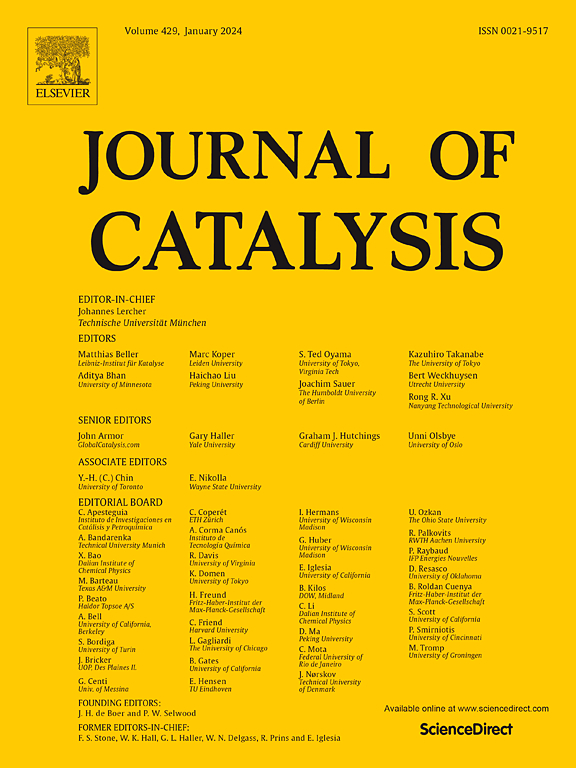Constructing well-distributed cerium oxide nanoparticles on alumina-carbon nanosheet for boosting the synthesis of imine from benzyl alcohol and aniline
IF 6.5
1区 化学
Q2 CHEMISTRY, PHYSICAL
引用次数: 0
Abstract
Considering the unique redox property and the excellent oxygen storage-diffusion ability of CeO2 nanoparticles as well as the advantages of large external surface area and accelerated mass transfer due to the open structure of two-dimensional nanosheets, well-distributed CeO2 nanoparticles supported on alumina-carbon nanosheet catalysts, which were prepared by a facile impregnation and subsequent pyrolysis procedure, were investigated for the synthesis of imine from benzyl alcohol and aniline by using air as the sole oxidant. The physical and chemical properties of the synthesized Ce/ALC catalysts were characterized by various techniques. It was found that an Al–Ce–O solid solution could be formed between supported Ce and Al within ALC during the pyrolysis procedure. The formation of Al–Ce–O solid solution is beneficial for generating more defective sites, promoting to adsorb and activate oxygen. Therefore, the activity of Ce/ALC catalyst for oxidative coupling of benzyl alcohol and aniline was enhanced with the addition of alumina. An appropriate Al/Ce ratio could obtain a large amount of surface Ce3+ ions, more readily available oxygen species and balanced acid-base sites, which were very crucial for achieving a high imine yield. The Ce/ALC-2 catalyst with Al/Ce ratio of ∼7 exhibited the highest catalytic activity. After 8 h of reaction at 80 °C, the benzyl alcohol conversion reached 99 % with an imine yield of 99 %, and the productivity of imine was 2.48 mmol gcat. −1h−1. The coordinatively unsaturated Ce3+–Vö defects were suggested as the active sites for the oxidative coupling of benzyl alcohol and aniline. In addition, this catalyst also exhibited good stability and recyclability, which might provide an alternative strategy for the oxidative coupling reaction.

在氧化铝-碳纳米片上构建分布均匀的氧化铈纳米颗粒,促进苯甲醇和苯胺合成亚胺
考虑到CeO2纳米颗粒独特的氧化还原性能和优异的氧储存-扩散能力,以及二维纳米片开放结构带来的大外表面积和加速传质的优点,采用快速浸渍和随后的热解工艺制备了分布均匀的CeO2纳米颗粒负载在氧化铝-碳纳米片催化剂上。以空气为唯一氧化剂,对苯甲醇和苯胺合成亚胺进行了研究。用各种方法对合成的Ce/ALC催化剂的理化性质进行了表征。在热解过程中,ALC内负载Ce与Al之间形成Al - Ce - o固溶体。Al-Ce-O固溶体的形成有利于产生更多的缺陷位点,促进氧的吸附和活化。因此,氧化铝的加入提高了苯甲醇与苯胺氧化偶联Ce/ALC催化剂的活性。适当的Al/Ce比可以获得大量的表面Ce3+离子、更容易获得的氧和平衡的酸碱位,这是实现高亚胺产率的关键。Al/Ce比为~ 7的Ce/ALC-2催化剂具有最高的催化活性。在80 ℃条件下反应8 h后,苯甲醇转化率达到99 %,亚胺收率为99 %,亚胺产率为2.48 mmol gcat。−1 h−1。提出了配位不饱和Ce3+ -Vö缺陷作为苯甲醇与苯胺氧化偶联的活性位点。此外,该催化剂还表现出良好的稳定性和可回收性,为氧化偶联反应提供了一种替代策略。
本文章由计算机程序翻译,如有差异,请以英文原文为准。
求助全文
约1分钟内获得全文
求助全文
来源期刊

Journal of Catalysis
工程技术-工程:化工
CiteScore
12.30
自引率
5.50%
发文量
447
审稿时长
31 days
期刊介绍:
The Journal of Catalysis publishes scholarly articles on both heterogeneous and homogeneous catalysis, covering a wide range of chemical transformations. These include various types of catalysis, such as those mediated by photons, plasmons, and electrons. The focus of the studies is to understand the relationship between catalytic function and the underlying chemical properties of surfaces and metal complexes.
The articles in the journal offer innovative concepts and explore the synthesis and kinetics of inorganic solids and homogeneous complexes. Furthermore, they discuss spectroscopic techniques for characterizing catalysts, investigate the interaction of probes and reacting species with catalysts, and employ theoretical methods.
The research presented in the journal should have direct relevance to the field of catalytic processes, addressing either fundamental aspects or applications of catalysis.
 求助内容:
求助内容: 应助结果提醒方式:
应助结果提醒方式:


